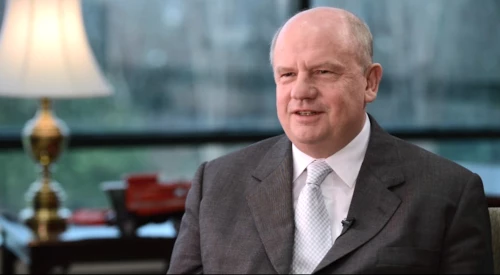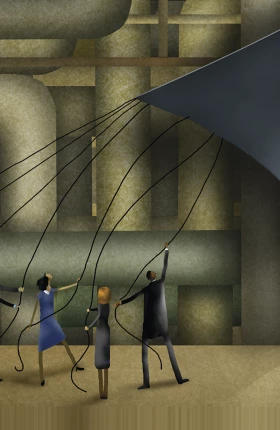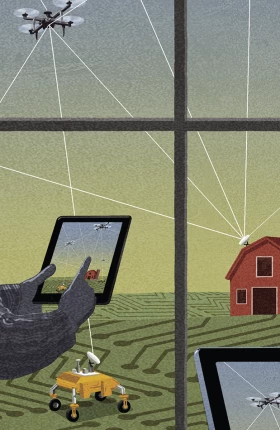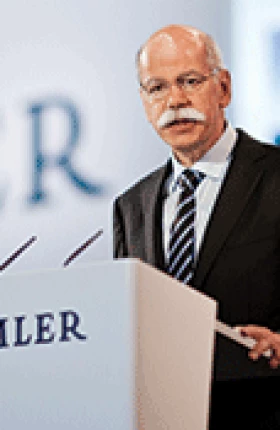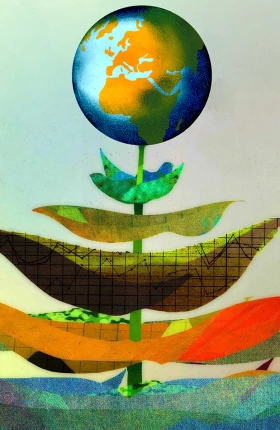AGCO was a study in complexity in 2004, when Martin Richenhagen joined the global agricultural-equipment manufacturer as chief executive. The result of multiple acquisitions, the company was officially created in a 1990 management buyout of Deutz Allis Corporation from its German parent.
Since taking the helm, Richenhagen has devoted himself to simplifying and decentralizing operations at AGCO. He has reduced the number of AGCO brands from 26 to 4 and has empowered local managers to run their business units without unnecessary interference from headquarters. Based in Duluth, Georgia, AGCO maintains manufacturing operations in the Americas, Europe, and Asia, and it generates sales in more than 140 countries.
During this time, Richenhagen has also been preparing AGCO for a digital world. Software, connectivity, and big data are playing increasingly important roles in farming. More and more farm equipment is built with the capability to communicate with other equipment, and farmers and dealers can monitor more and different types of performance through digital apps.
The digitization of farming makes agricultural equipment an even more complicated business. Tractors, for example, now need to communicate with combines and other equipment made by different manufacturers, forcing suppliers to collaborate. But if there is much to do, there is also much to gain: the winners will generate greater customer loyalty by helping farmers improve yields, efficiency, and precision.
Richenhagen recently sat down for a discussion with Felix Stellmaszek, a BCG partner and managing director, to discuss complexity. Edited excerpts from that conversation follow.
When you took over at AGCO in 2004, the company had made roughly 30 acquisitions over 15 years. How did you manage such a complex portfolio, particularly because you not only inherited acquisitions but also made select acquisitions?
The first 15 years, they didn’t manage the acquisitions, they just made acquisitions. Their strategy was to buy everything that became available, cheap and fast. My idea was to look for postmerger integration opportunities and synergies. When I joined, we had exactly 26 brands. We are now down to four.
So in AGCO today you have four brands, but you have operations across five continents and ten lines of business ranging from high-horsepower tractors to grain storage. How do you manage that complexity from an organizational perspective?
We are very decentralized, and we try to have the units tailored in a way so that they’re not too big and unit management is completely in control of running the unit.
You have operations not only in North America and Europe, which are more developed markets, but also in Asia and Africa, which are rapidly changing environments. How do you manage that kind of complexity?
We like to hire local managers. So in Germany, for example, we run the business mainly with Germans, and in Brazil, we hire mainly Brazilians. We do have job rotation, and we try to move people to different countries. We are different in that we don’t believe that it’s the best solution to have the Americans running all the overseas operations, as some of our competitors do.
Against that backdrop, what are the qualities in your leadership team that you are looking for? What are the capabilities that you also want to build? And how do you build them?
We like people who work well in a global environment, understand different cultures, and also speak different languages, which is sometimes a little bit difficult to find in the U.S.
The agriculture industry is undergoing huge amounts of change. Think about moving from selling iron, like high-horsepower tractors, to selling solutions that enable precision farming. What is AGCO doing in order to ensure that you’re emerging as the winner in this race?
In the future, you will see a higher level of mechanization not only in tractors, but also implements—harvesting combines and so on. Those implements have to be connected, and they must not only communicate with one another but also with products from other companies and other brands. They will have to take into consideration seeds, fertilizers, pesticides, and so on to optimize farming. You will need to look at farming as a whole process, instead of saying, “Today, I used my tractor, and next week, I will use my combine.”
We have all this information and also all these data that are now abundantly available, how do you separate the noise from the important pieces of information?
In farming, you need to think about what will change in the future. Right now, people think that the master of the information is the tractor because it’s typically the biggest investment and it’s pulling or carrying other implements. We think that in the future the driving force will be the implements.
We think that the implements will tell the tractor what to do, will define the speed, will define the turning radius and so on. That’s a major change, but I think this is the next step you will see.
How do you keep your finger on the pulse of your customers and your frontline? I know for example you are test driving all the new products yourself, but are there other mechanisms or processes you use?
You just meet with your customers and talk with them. Farmers are pretty outspoken. They’re pretty normal people. So, in our case, you don’t have to work through hierarchies. You just visit customers. You visit dealers, and you need to make sure you do it not only in one country or in one area of the world. Once a year, I visit customers in South America. I do that in the U.S. on a frequent, regular basis and in Europe as well. In the future, you will have to do that also in Africa and China.
Complexity doesn’t come only with risk. It also comes with opportunities. How do you take advantage of some of the opportunities associated with complexity?
I think it’s very important to think in networks and to include not only your customer and your dealers but also companies from related industries.
Our tractors today can communicate with a lot of other products. During harvest, our combine can already find out what the crop prices are. When you need a part, you can communicate with your dealer. Your dealer can communicate with you to tell you that you’re maybe running too fast or you don’t have the right torque or whatever.
Through a simple app, farmers can basically see how their product is working and what it is doing, how much it’s producing, how much fuel it is consuming, and things like that. So it’s about thinking in networks.
In thinking about networks, do you have deliberate targets for the suppliers you want to forge partnerships with?
Yes, we have clearly defined those partners that we want to have a very good and very intense relationship with. There are smaller family-owned companies in our industry that do certain things better than the big three in seeding, tillage, and certain harvesting processes, such as self-propelled vine harvesting.
What is the legacy that you want to leave behind?
I would like to make AGCO a business that is too big to be taken over easily. So I’m thinking about $15 billion in revenues by 2016, margins of 12 percent by 2015, and a complete integration of all the acquisitions we have done. We want to be the leader in customer-perceived quality by 2016 as well.
